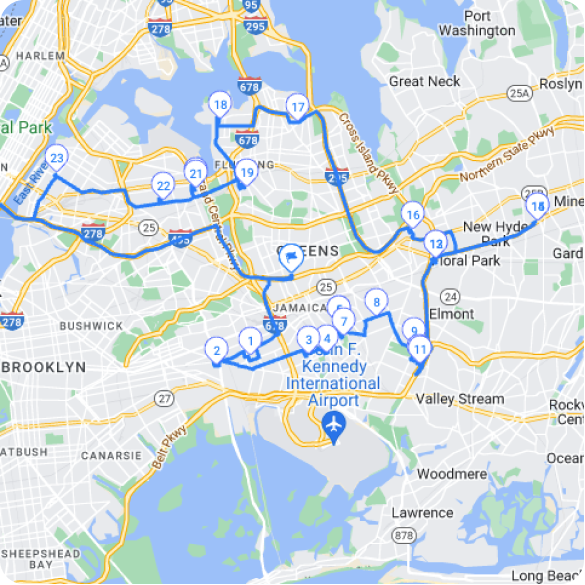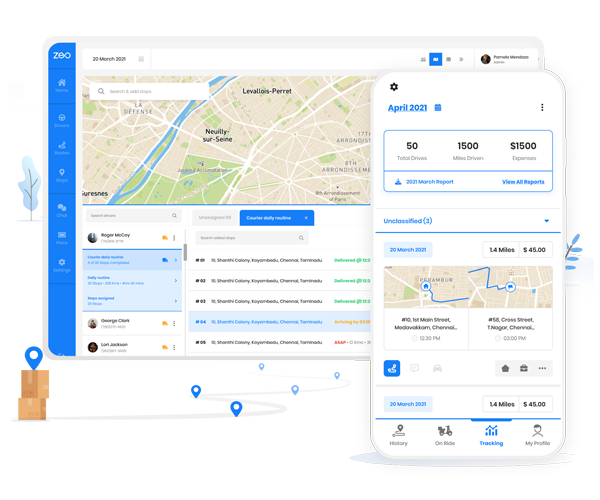Updated on: April 14, 2025
Getting deliveries from point A to point B sounds simple—until you’re managing dozens of stops, unpredictable traffic, and tight schedules. That’s where Google Maps Route Planner comes in. It gives drivers turn-by-turn directions, live traffic updates, and a clear view of every stop on the map. But here’s the catch: manually adding and arranging multiple stops can be a hassle.
That’s why businesses often pair Google Maps with a route planning app. This combination effectively optimizes routes, cut down on drive time, and keeps deliveries running smoothly. It’s a small upgrade that makes a big difference—saving time, fuel, and a whole lot of stress.
It’s time to find out how you can leverage Google Maps route optimization for delivery planning.
How to plan a delivery route with Google Maps
Many small and medium-sized businesses start with Google Maps Route Planner as their first step in mapping delivery stops.
The optimized route planning systems by Google involve listing your key addresses and plugging them into Google’s platform. Then, you can share the directions with drivers.
It’s simple, but there are important details to watch for when creating routes.
Create Your Routes
When you begin planning a delivery route with Google Maps, the starting point is often a spreadsheet or a list of customer addresses. Enter each stop one by one in the route planner and arrange the order to fit your driver’s schedule. Now, you can use this process on a desktop browser or even a mobile app.
At a technical level, all you’re doing is sending address data to Google’s geocoding function in the background. It lets the system pinpoint the latitude and longitude, which Google Maps decodes to show you possible routes.
You can add up to 25 waypoints (including start and end). After you’ve set those points, you can view the estimated travel time and distances between stops.
Below are some quick tips for creating routes:
- Break larger deliveries into smaller batches to stay within the waypoint limit.
- Double-check every address for errors to ensure geocoding accuracy.
- Use the “Add Stop” button to include each location in the correct sequence.
- Tap “Directions” to confirm the estimated time and distance before starting the trip.
- Keep an eye on live traffic data since conditions can change in busy areas.
Limitations
You can use Google Maps Route Planner to get the drivers from one point to another with efficient route planning. But there are a few drawbacks as well.
25-waypoint limit
The first hurdle is the 25-waypoint limit. Large delivery setups with dozens of stops might need a workaround or a different system. Splitting big routes into multiple segments can be time-consuming and complicate dispatch.
Lacks specialized route optimization tools
Some teams have also noticed that it lacks the deeper features seen in specialized Route Optimization tools. For instance, you can’t directly manage multiple drivers and their capacity.
A few more limitations include:
- No capacity planning features for large fleets.
- Limited scheduling options for time-specific deliveries.
These boundaries push many businesses to look for more robust software, such as Zeo Route Planner. This software offers automated route optimization that dynamically arranges stops. Also, you can add stops by typing to build it efficiently, considering real-time traffic conditions, driver shifts, and delivery constraints.

increase fuel savings
Hassle Free Deliveries & Pickups!
Optimize routes with our algorithm, reducing travel time and costs efficiently.
Get Started for Free
Unlike Google Maps Route Planner, which requires manual adjustments, Zeo Route Planner automatically optimizes delivery sequences, reducing fuel costs, improving ETAs, and making multi-driver fleet management seamless.
Google Maps Route Planner vs Route Optimization
You may assume that Google Maps Route Planner takes care of everything related to planning trips. But that’s not exactly the case.
Route Optimization is a broader process that involves sorting through large address sets, considering driver workloads, and even factoring in delivery time windows.
But then, Google’s planner only gives you a series of directions and does not automatically decide the best sequence if you’ve got more than a handful of stops.
Route optimization solutions like Zeo Route Planner are therefore useful. They gather data from a Distance Matrix API (Google’s or another provider’s) and run advanced algorithms, such as the Traveling Salesman Problem or Vehicle Routing Problem.
These systems help assign the right stops to the correct driver and arrange them in the best order to reduce the number of miles traveled.
In other words, Google Maps Route Planner is great for quick and simple guidance, but it’s not designed to run a complex fleet.
Below are the major differences:
| Aspect | Google Maps Route Planner | Route Optimization |
| Primary Focus | Directions and basic trip planning | Assigning stops, best sequencing, fleet management |
| Max Waypoints | 25 | Can handle far more, often hundreds or thousands |
| Fleet Management | Not built-in | Often includes driver scheduling and capacity rules |
| Custom Constraints | Limited | Handles time windows, vehicle load, driver breaks |
Conclusion
That’s it! We’ve now covered the core steps and analyzed a few limitations of using Google Maps Route Planner. You can certainly use it to plan the trip and map the pit stops.
For a smaller set of stops, Google Maps Route Planner is enough. But if you’re juggling many drivers and loads of stops, then full Route Optimization software might be a better fit.
If your team needs a system that handles more stops, think of a more brilliant dispatch that keeps scheduling under control — with Zeo Route Planner. It helps deliver packages efficiently, including everything from importing addresses to recipients’ notifications to customer dashboards.
Book a demo to see how it can cut travel time, reduce driver strain, and keep your routes running smoothly.

Are you a fleet owner?
Want to manage your drivers and deliveries easily?
Grow your business effortlessly with Zeo Routes Planner – optimize routes and manage multiple drivers with ease.

increase fuel savings
Hassle Free Deliveries & Pickups!
Optimize routes with our algorithm, reducing travel time and costs efficiently.
Get Started for Free






















